
About UsThe Numismatic Bibliomania Society is a non-profit organization promoting numismatic literature. For more information please see our web site at coinbooks.org SubscriptionsThose wishing to become new E-Sylum subscribers (or wishing to Unsubscribe) can go to the following web page link MembershipThere is a membership application available on the web site Membership Application To join, print the application and return it with your check to the address printed on the application. Membership is only $15 to addresses in the U.S., $20 for First Class mail, and $25 elsewhere. For those without web access, write to: David M. Sundman, Secretary/TreasurerNumismatic Bibliomania
Society AsylumFor Asylum mailing address changes and other membership questions, contact David at this email address: dsundman@LittletonCoin.com SubmissionsTo submit items for publication in The E-Sylum, just Reply to this message, or write to the Editor at this address: whomren@coinlibrary.com
BUY THE BOOK BEFORE THE COINYou won't regret it! |
- WAYNE'S WORDS: THE E-SYLUM JANUARY 13, 2013
- KOLBE & FANNING’S 2013 NEW YORK BOOK SALE A SUCCESS
- NEW BOOK: THE DRAPED BUST HALF DOLLARS OF 1796-1797
- NEW BOOK: THE UNIFORM COINAGE OF INDIA 1835 – 1947
- NEW BOOK: JUDAEA AND ROME IN COINS 65 BCE – 135 CE
- NEW BOOK: COLLECTING WORLD COINS, 1901-PRESENT, 14TH EDITION
- NEW BOOK: QUARTERAMA: IDEAS AND DESIGNS OF AMERICA'S STATE QUARTERS
- BOOK REVIEW: THE PRIVATE SKETCHBOOK OF GEORGE T. MORGAN
- ERIC P. NEWMAN NUMISMATIC EDUCATION SOCIETY PLANS SOME SALES
- ANS LIBRARY REVAMPS AUCTION CATALOG STORAGE
- CASHING THE WARRANT THAT PAID FOR ALASKA
- HERITAGE OFFERS THE JOHN W. ADAMS COLLECTION OF BETTS MEDALS
- CORRECTION: STARR GILMORE BIBLIOGRAPHY
- NOTES FROM E-SYLUM READERS: JANUARY 13, 2013
- MORE ON JULES FONROBERT
- QUERY: WHAT IS THIS EBAY 'MINT DIE'?
- 2013 PRESIDENTIAL INAUGURAL MEDAL RELEASED
- THE TED CRAIGE SALE, PART II
- HARVEY STACK REMEMBERS HAROLD BAREFORD
- ARTICLE PROFILES NUMISMATIST EDWARD T. NEWELL
- NUMISMATIC VOCABULARY WORDS: PINSCRATCH AND FACEPLATES
- FORMER U.S. MINT DIRECTOR MOY ON THE TRILLION DOLLAR COIN
- INFLATION MONEY AND PROPOSED PLATINUM COIN DESIGNS
- J.P. MORGAN'S 1895 COIN LOOPHOLE GAMBIT
- COULD THE U.S. GOVERNMENT ISSUE WARRANTS?
- NISEI CONGRESSIONAL GOLD MEDAL GOES ON NATIONAL TOUR
- NUMISMATICS IN THE PRINCIPALITY OF MONACO
- QUERY: W.W.C. WILSON COMMERCIAL TERCENTENARY MEDAL INFO SOUGHT
- TREASURY SECRETARY NOMINEE JACK LEW'S LOOPY SIGNATURE
- QUERY: INFORMATION ON DENNIS W. SIBERT SOUGHT
- ANCIENT GOLD COIN HOARD DISCOVERED IN IRAQ
- ALAN V. WEINBERG'S REPORT ON THE 2013 F.U.N. SHOW
- SUSPECT TRIES TO EAT COUNTERFEIT MONEY
WAYNE'S WORDS: THE E-SYLUM JANUARY 13, 2013

New subscribers this week include Brian Bell, courtesy of Geoffrey Bell and Greg Laptevsky of Coin Supply Planet. Welcome aboard! We have 1,618 email subscribers, plus 208 followers on Facebook.
This week we open with a short note on the Kolbe-Fanning New York sale, information on five new numismatic books, and a review. The big news comes next - there will be some sales of material from the Eric P. Newman collection, a treasure some 90 years in the making.
Other topics include the ANS Library, the Adams Betts medal collection, Jules Fonrobert, Harold Bareford, Ted Craige, Edward Newell, and the 2013 Presidential Inaugural medal.
To learn more about the Draped Bust Half Dollars of 1796-1797, the Carter Glass mint medal, pinscratches, faceplates, inflation money, and how J.P. Morgan's coin loophole saved the U.S. in 1895, read on. Have a great week, everyone!
Wayne Homren
Editor, The E-Sylum
KOLBE & FANNING’S 2013 NEW YORK BOOK SALE A SUCCESS
David Fanning writes:
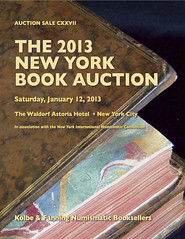 A full report will have to wait, as we just returned home, but this year's New York Book Auction was a great success, and we thank the many bidders who attended the sale, gave us bids in advance, or participated online. The sale brought about 140% of estimate, with some remarkable results. The PRL should be posted to the Kolbe & Fanning website by Monday night.
A full report will have to wait, as we just returned home, but this year's New York Book Auction was a great success, and we thank the many bidders who attended the sale, gave us bids in advance, or participated online. The sale brought about 140% of estimate, with some remarkable results. The PRL should be posted to the Kolbe & Fanning website by Monday night.
NEW BOOK: THE DRAPED BUST HALF DOLLARS OF 1796-1797
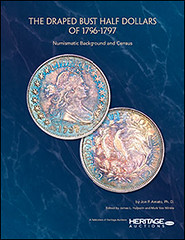 Heritage Auctions has announced the publication of The Draped Bust Half Dollars of 1796-1797, by Jon Amato, and edited by Jim Halperin and Mark Van Winkle, now available online by clicking on this link, or via email at CatalogOrders@HA.com.
Heritage Auctions has announced the publication of The Draped Bust Half Dollars of 1796-1797, by Jon Amato, and edited by Jim Halperin and Mark Van Winkle, now available online by clicking on this link, or via email at CatalogOrders@HA.com.
"This book is the culmination of more than 10 years of research into the Draped Bust Small Eagle half dollar series," said Greg Rohan, President of Heritage Auctions, "one of the most coveted type coins in American numismatics and one about which, until now, remarkably little has been written."
Expertly researched and comprehensively documented, the book includes a profusely illustrated discourse of the four Overton varieties and one major die state of this important two-year design type. Additionally, it features a census of 270 Draped Bust Small Eagle half dollar specimens. A full page is devoted to each coin, including an obverse and reverse image, a description of key identification markers, and the provenance for each.
"We believe this work will be the premier reference for 1796-1797 half dollars for years to come," said Rohan. "Institutions having an extensive numismatic library or coin cabinet will find it a valuable complement to their holdings, while catalogers charged with writing up specimens for auction now have an indispensable source of background and pedigree information."
The book will also be an important resource to coin dealers seeking to purchase one or more '96 or '97 half dollars for a client or for inventory, and to collectors who own, have owned, or desire to own one of these important coins.
Heritage has also set up special web page, HA.com/JonAmato , which will feature periodic updates of new discoveries in the census of '96 and '97 Draped Bust Half Dollars, as well as information about recent results for the coins at auction.
To order, see: www.ha.com/c/catalog-orders.zx?catalog=EarlyHalfDollars
To read the complete press release, see:
The Draped Bust Half Dollars Of 1796-1797, By Jon Amato, Now Available From Heritage Auctions
(www.ha.com/Heritage-Auctions-press-releases-and-news/the-draped
-bust-half-dollars-of-1796-1797-by-jon-amato-now-available-from-heritage-auctions.s?releaseId=2305)
NEW BOOK: THE UNIFORM COINAGE OF INDIA 1835 – 1947
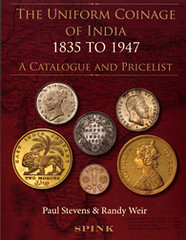 THE UNIFORM COINAGE OF INDIA
THE UNIFORM COINAGE OF INDIA
1835 – 1947
A Catalogue and Price List
By
Paul Stevens and Randy Weir
Published by Spink
Crown quarto, pp. xii, 360. Illustrated in colour. Casebound.
Price £75 (plus postage and packing)
This new book is based upon the work of Major F. Pridmore (The Coins of the British Commonwealth of Nations. Part 4, India. Volume 2, Uniform Coinage), published in 1980. The market for Indian coins has developed considerably in that time and the need for an up-to-date reference work with current values has been apparent for some time.
Paul Stevens and Randy Weir have combined their extensive knowledge and experience totalling over 60 years to produce this comprehensive handbook for collectors. They have amassed information from numerous sources and have gathered together superb photographs, all shown at 1 ½ times actual size, not only of the currency issues, but also of Proof Restrikes, Early Proof Restrikes, Original Proofs and rarely seen Patterns. Also shown are close-ups of varieties and line-drawings to illustrate points that could not be easily shown in photographs.
Information about weight, diameter, metal, edge and axes is also given with cross references to Pridmore numbers with additional comments to show provenance. This is the new standard catalogue for the coins of British India for the period and includes prices in US$ in multiple grades together with mintage figures.
For more information, or to order, see: The Uniform Coinage of India 1835 to 1947 A Catalogue and Pricelist by Stevens, P. and Weir, R (www.spink.com/books-publications/book-description.aspx?id=70)
NEW BOOK: JUDAEA AND ROME IN COINS 65 BCE – 135 CE
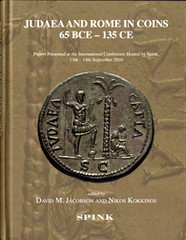 JUDAEA AND ROME IN COINS
65 BCE – 135 CE
JUDAEA AND ROME IN COINS
65 BCE – 135 CE
Papers Presented at the International Conference Hosted by Spink, 13-14th September, 2010
Edited by David M. Jacobson and Nikos Kokkinos
JUST PUBLISHED BY SPINK
Crown quarto, pp. x, 246. Casebound.
Price £50 + Postage and packing
The 14 papers presented in this volume are based on presentations at an international two-day conference held at Spink & Son in London on 13-14 September, 2010.
The period covered spans the Roman conquest of Judaea by Pompey through to the last major Jewish uprising against Rome under Simon Bar-Kokhba, encompassing the age of the Herods and the birth of Christianity.
The past few decades have seen considerable advances in numismatic scholarship dealing with this period, stimulated by archaeological exploration and important coin finds, which have shed new light.
The contributors to this volume have pooled their specialist knowledge to illuminate important issues in the history of Judaea and its relationship to Rome.
CONTRIBUTORS TO THIS VOLUME:
Andrew Burnett, Rachel Barkay, Anne Lykke, Danny Syon, Robert Bracey, Nikos Kokkinos, Robert Deutsch, David Hendin, David Jacobson, Ted Buttrey, Marius Heemstra, Kevin Butcher, Boaz Zissu, Larry Kreitzer.
For more information, or to order, see: JUDAEA AND ROME IN COINS 65 BCE – 135 CE (staging.spink.com/books-publications/book-description.aspx?id=68)
NEW BOOK: COLLECTING WORLD COINS, 1901-PRESENT, 14TH EDITION
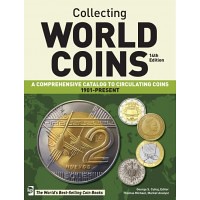 Collecting World Coins, 1901-Present, 14th Edition
Collecting World Coins, 1901-Present, 14th Edition
A Comprehensive Catalog to Circulating Coins
By George S. Cuhaj & Thomas Michael
The 14th edition of Collecting World Coins Catalog, 1901-Present, is designed to offer a focused approach to world coin collecting, catering to the needs of the collector interested only in coinage minted for circulation in the past 100+ years.
Circulating coins are used in everyday commerce and readily available to all, often turning up in pocket change at the end of the day. The catalog tells a comprehensive and complete story of the history of the modern world through the changes in government, monetary reforms and wars as recorded in circulating coins.
This edition features:
- Up-to-date and complete Euro Coin images and values
- 30,000 images for easy coin identification
- Current market values in up to 5 grades
Additional Feature: 30,000 Black & White Illustrations Paperback
ISBN: 13 9781440236181
Author/Speaker/Editor: George S. Cuhaj & Thomas Michael
Number Of Pages: 1104
Format: Book
File/Trim Size: 8.25 x 10.88
For more information, or to order, see: Collecting World Coins, 1901-Present, 14th Ed. (www.shopnumismaster.com/collecting-world-coins-1901-present-u3686)
NEW BOOK: QUARTERAMA: IDEAS AND DESIGNS OF AMERICA'S STATE QUARTERS
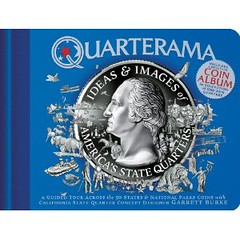 In crafting the selected prototype for the California quarter, the noted graphic designer Garrett Burke created one of the most successful quarters in the program. An now, in this comprehensive and brilliantly designed and illustrated book, Burke is bringing the same taste, scholarship, historical sensibility, and talent to the entire U.S. Quarter Program that he brought to the design of his acclaimed California entry. --Kevin Starr, University of Southern California, California State Librarian Emeritus.
In crafting the selected prototype for the California quarter, the noted graphic designer Garrett Burke created one of the most successful quarters in the program. An now, in this comprehensive and brilliantly designed and illustrated book, Burke is bringing the same taste, scholarship, historical sensibility, and talent to the entire U.S. Quarter Program that he brought to the design of his acclaimed California entry. --Kevin Starr, University of Southern California, California State Librarian Emeritus.
The monumentally popular state quarters are the fifty-six unique creations honored in the colorful book, Quarterama: Ideas & Designs of American's State Quarters. A tribute to each of the fifty states, in the order they entered the Union, plus the District of Columbia and five US Territories, was minted and distributed five times a year from 1999-2009, and each state's coin was uniquely designed to represent that region. Children and adults eagerly awaited the distribution of the next coin in the series and marveled at the detail on the back of each quarter. George Washington's face is on the front of all quarters, as it has been since 1932.
In Quarterama, the compact history of each state unfolds along with lavish illustrations and a greatly enlarged rendition of the state quarter, letting readers see up close the detail on each coin. The bindery of the hardcover edition of this book doubles as a collector coin album.
Author Garrett Burke is also the concept designer of the California state coin. The design, which was selected by Governor Arnold Schwarzenegger from over 8,000 entries, celebrates nature, including naturalist John Muir, Yosemite Valley, and the California condor. Other quarters feature scenes sculpted by gifted artists representing their own states. One of the most unusual set of pages is for Alabama. The Braille Code, honoring Alabama native Helen Keller, who opened the world's eyes and ears by her courage, is featured and readers are instructed as to how to decipher the code that lets the blind read. Humorous and beautiful illustrations make for interesting pages.
Each state's pages teach history in a nutshell, plus offer small tidbits of information: Four Ohio state quarters [were] carried aboard the space shuttle Columbia in March, 2002.Ohio was the seventeenth state admitted to the Union and calls itself The Birthplace of Aviation Pioneers.
A shorter section is devoted to America's Treasured National Parks quarters, which went into circulation in 2010. Five new quarters will be released annually until 2021. Hopefully Burke will publish another book similar to Quarterama, which will be a hit with all coin collectors, professional and recreational, young and old, plus history teachers and scholars.
Burke has crafted art and logos for major movie studios and pop culture brands, including Star Wars and Dr. Seuss and has designed commemorative medals. He is an honors graduate of Pratt Institute's School of Art and Design. --Penny Hastings March 24, 2011
Feeling numismatic? Just in time for Presidents Day comes Quarterama by Garrett Burke (Sunbelt, $50). This hands-on, fabulously illustrated gift book presents informative, behind-the-scenes stories of the U.S. Mint's 50 State Quarters program. It includes a built-in album for collecting all 50 quarters, minted between 1999 and 2009. Burke's design for the California state quarter was selected over 10,000 other entries. It depicts naturalist John Muir viewing Half Dome in Yosemite Valley as a condor soars overhead. This title is a must-have for coin collectors and students from elementary school through high school. --Allen Pierleoni, The Sacramento Bee
Price: $36.50
About the Author
Garrett Burke's creative fingerprints are visible across popular culture. One of his ideas now circulates as half a billion pieces of American history. Topping 8,300 entries, Gov. Arnold Schwarzenegger selected Garrett s coin concept honoring John Muir in Yosemite Valley to be California's 2005 commemorative state quarter, part of the United States Mint's phenomenally successful 50 State Quarters program. Profiled in national media and a popular public speaker, Burke has appeared before libraries, colleges, elementary and middle schools, coin clubs, nature organizations and civic groups to present an unconventional and entertaining look at the stories inside everyday coins.
Garrett is an active member of the numismatic community and has designed two crowd-pleasing commemorative medals for the World's Fair of Money. He is the recipient of the American Numismatic Association s prestigious Art Award for Excellence in Medallic Sculpture and the John Muir Association's John Muir Conservation Award. In addition to writing the foreword to numismatic historian David Bowers authoritative A Guide Book of Washington and State Quarters, Garrett was featured on the nationwide PBS television interview series Between The Lines, to reveal the meanings behind America s favorite pocket change. In addition, Garrett has crafted art, logos, movie posters and packaging for Warner Bros., 20th Century Fox, Paramount, Sony, LucasArts, Nickelodeon, Mattel, XBOX and Disney.
To order from Amazon, see: Quarterama: Ideas and Designs of America's State Quarters (www.amazon.com/Quarterama-Ideas-Designs-Americas-Quarters/dp/0984562400)
BOOK REVIEW: THE PRIVATE SKETCHBOOK OF GEORGE T. MORGAN
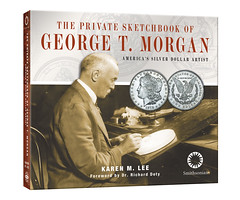 I've had a chance to review my copy of Karen M. Lee's The Private Sketchbook of George T. Morgan America's Silver Dollar Artist. It's a great read, providing an interesting overview of the industrial England Morgan was born in to, his early training as an engraver, his immigration to Philadelphia to take up a position at the United States Mint and his subsequent career as one of our noted designers of medals, pattern coins, commemorative issues and, of course, the great silver dollar that bears his name. A really well done book.
I've had a chance to review my copy of Karen M. Lee's The Private Sketchbook of George T. Morgan America's Silver Dollar Artist. It's a great read, providing an interesting overview of the industrial England Morgan was born in to, his early training as an engraver, his immigration to Philadelphia to take up a position at the United States Mint and his subsequent career as one of our noted designers of medals, pattern coins, commemorative issues and, of course, the great silver dollar that bears his name. A really well done book.
I do have one dispute with the work, however. The cover of the book shows a portion of a wonderful photograph an older Morgan at work on a plaster model; a complete rendering of the photo is shown on page 29 of the book. On the copyright page of the book, a caption regarding the cover states that:
"George T. Morgan is shown (in a photograph provided courtesy of the artist's family) working on a plaster model for a U.S. coin design."
The caption for page 29 is more definite, stating that:
"George T. Morgan at work: adjusting the plaster for his famous silver dollar."
I suspect that both captions are in error. I believe that Morgan is, in fact, putting the finishing touches on the U. S. Mint medal honoring Secretary of the Treasury Carter Glass (U. S. Mint medal list no. 210). I admit that it is difficult to see exactly what Morgan is working on on the cover of the book (its glossiness does not really lend itself to detail) and is only marginally better on the full photo contained inside. I base my conclusion on a much larger, more detailed reproduction of the photo contained on the genealogy website Ancestry.com.
Those with a subscription to the site can find the photo at http://trees.ancestry.com/tree/44611947/person/6236094978/media/5?pgnum=1&pg=0&pgpl=pid%7cpgNum .
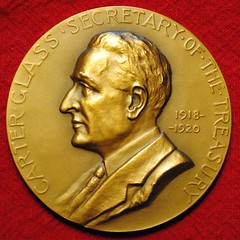 If you enlarge the photo to its full proportions and angle your view of your computer screen, it's possible to see the distinctive features of the Glass medal. For comparison's sake, I've attached a photo of the medal from my own collection, as well as a close up of Morgan's signature and date (1922) on that medal. I'd be interested in hearing what other readers of The E-Sylum think.
If you enlarge the photo to its full proportions and angle your view of your computer screen, it's possible to see the distinctive features of the Glass medal. For comparison's sake, I've attached a photo of the medal from my own collection, as well as a close up of Morgan's signature and date (1922) on that medal. I'd be interested in hearing what other readers of The E-Sylum think.

Again, this is a minor quibble with an otherwise well-made work. I greatly appreciate Ms. Lee's bringing a number of previously unknown Morgan photos to the numismatic community. Now if only someone could find a photo of William Barber.
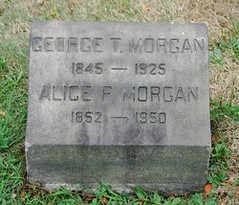 By the way, if any Morgan dollar collectors find themselves in Philadelphia without anything to do, they can pay their respects to George Morgan and his wife Alice by visiting their graves at historic Woodlands Cemetery; you can find the coordinates at
www.findagrave.com/cgi-bin/fg.cgi?page=gr&GRid=95266578 . It's a modest little marker. For all the joy he's given and continues to give collectors, you would think he rates better.
By the way, if any Morgan dollar collectors find themselves in Philadelphia without anything to do, they can pay their respects to George Morgan and his wife Alice by visiting their graves at historic Woodlands Cemetery; you can find the coordinates at
www.findagrave.com/cgi-bin/fg.cgi?page=gr&GRid=95266578 . It's a modest little marker. For all the joy he's given and continues to give collectors, you would think he rates better.
THE BOOK BAZARRE
MAIL BID SALE # 18 CLOSES SATURDAY FEBRUARY 2, 2013
CATALOGS ARE BEING SENT TO ALL INDIVIDUALS ARE ON OUR
MAILING LIST, AND ON REQUEST AT NO CHARGE. THE CATALOG
IS ALSO VIEWABLE ON OUR WEB SITE.
BIDDERS MAY ENTER THEIR BIDS BY MAIL, TELEPHONE, EMAIL OR FAX.
DAVID SKLOW – FINE NUMISMATIC BOOKS
P.O. BOX 6321
COLORADO SPRINGS, CO 80934
TEL: (719) 302-5686
FAX: (719) 302-4933
numismaticbooks@aol.com
www.finenumismaticbooks.com.
ERIC P. NEWMAN NUMISMATIC EDUCATION SOCIETY PLANS SOME SALES
The following announcement (which apparently circulated at the F.U.N. show this week) was published online in the JR Newsletter (a publication of the John Reich Collector's Society) earlier today:
The Eric P. Newman Numismatic Education Society is selling some of its items from the extensive collection assembled over 90-plus years. All sale proceeds will be used to support various not-for-profit organizations as well as continuing the Eric P. Newman Numismatic Education Society's mission of funding operations and exhibits at the Newman Money Museum at Washington University in St. Louis.
Eric P. Newman, now almost 102 years of age, remains an American numismatist still engaged in scholarly writing and research. He hopes that others will be able to share his excitement and passion for numismatics and enjoy the history, artistry, and collecting of these items.
For any inquiries, please contact Stuart Levine at stuartlevine@comcast.net
Stuart Levine writes:
I can confirm the release by the Foundation. Please share it with your readers.
I would like to clarify the perception of my role: I have been selected by EPNNES to provide advice and guidance regarding selling some of their numismatic holdings. No determinations have been made as of yet regarding the details of the disposition of any of the holdings of the Foundation. We will keep the numismatic community informed as decisions are made by the Foundation. I look forward to working with the Numismatic Bibliomania Society toward the betterment of EPNNES.
To read the complete article, see: JR Newsletter: 13 January 2013 (123) (jr-newsletter.blogspot.com/)
ANS LIBRARY REVAMPS AUCTION CATALOG STORAGE
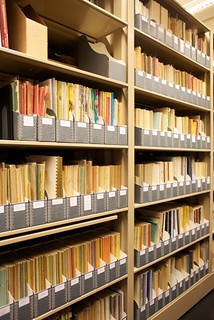 In June 2012, I received a confirmation letter stating that my application for grant funding assistance for preservation needs in the ANS Library was being awarded $5,000 from The Bay and Paul Foundations, an independent private foundation located in New York City. I was thrilled, not only because this is the first grant I wrote that resulted in funding (and such applications can take a great deal of time), but because there are limited funds available in the ANS Library budget that can go towards preservation projects (of which there are many).
In June 2012, I received a confirmation letter stating that my application for grant funding assistance for preservation needs in the ANS Library was being awarded $5,000 from The Bay and Paul Foundations, an independent private foundation located in New York City. I was thrilled, not only because this is the first grant I wrote that resulted in funding (and such applications can take a great deal of time), but because there are limited funds available in the ANS Library budget that can go towards preservation projects (of which there are many).
Although still a very modest sum, the grant will allow for very necessary re-housing of rare auction catalogs and periodicals and also for a general inventory of preservation needs in the rare book room with help from a professional conservator. The project allowed me to bring in a student intern with an interest in preservation and rare books to gain hands-on experience dealing with issues that are encountered by all libraries.
In working so closely with the rare books over a period of time, I was reminded of the popular question that I am repeatedly asked: Are gloves required in order to handle rare items? The short answer is no, although it is worth reviewing why. The policy of wearing white gloves was initially intended as a barrier to prevent dirt and skin oils from damaging paper items. However, as the British Library attests, wearing white gloves is no longer considered best practice when handling paper collections. I have always preferred the practice of not wearing gloves but handling with clean hands for the very reasons outlined in the articles that were linked to in a recent issue of The E-Sylum. In particular, delicate or brittle pages may more easily tear if the added barrier of a glove is present.
The dexterity of a clean, uncovered hand can more delicately handle the pages than a glove, which is still prone to pick up dirt or absorb sweat and oils of the user. In addition, users may feel a false sense of protection in wearing white gloves, which can lead to increased mishandling of the item. There is also an aesthetic appeal that is lost when wearing gloves. If the user cannot feel the physical attributes of the item, important information about the object may be missed, as a perceived interaction with the physical attributes of the paper can help to provide important and complementary information. It is not clear when the practice of wearing white gloves to handle library and archival materials began, but for preservation purposes, it may have developed from photographers wishing to prevent fingerprints from damaging their negatives (a practice that could have started in the mid-19th century).
What’s more, there is no scientific evidence that even regular handling of paper collections with bare hands causes chemical damage to the item. So as we worked our way through the rare book room items, we did not use gloves but approached the project with clean hands and steady fingers.
To read the earlier E-Sylum article, see: MORE ON WEARING COTTON GLOVES (www.coinbooks.org/esylum_v15n19a14.html)
CASHING THE WARRANT THAT PAID FOR ALASKA
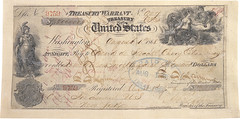 Regarding the $7.2 million Warrant that paid for Alaska (that was mentioned in this week's issue of The E-Sylum), nothing in my research has indicated that, at that time, the Treasury provided custody services for gold for entities other than the US Government. Even today, it's the Federal Reserve Banks rather than the Treasury that provide this service for foreign governments.
Regarding the $7.2 million Warrant that paid for Alaska (that was mentioned in this week's issue of The E-Sylum), nothing in my research has indicated that, at that time, the Treasury provided custody services for gold for entities other than the US Government. Even today, it's the Federal Reserve Banks rather than the Treasury that provide this service for foreign governments.
Presuming that this transaction would have followed the same pattern as any similar transaction, most likely, a representative of the Russian government would have presented the Warrant to the sub-Treasury in New York and received the $7.2 million in gold.
I speculate that the Russians would have received the gold in "fine bars" (bars of essentially pure gold worth about $5,000 each) as these were preferred for export over coin (as they were easier to count than bags of double eagles and didn't suffer from abrasion in transit). The bars would have been produced at the New York Assay Office and would, most likely, have been composed mostly of gold from California, as that was where most of our domestic gold was produced.
Certainly, the bars could have contained some gold from Colorado. However, at this time the Denver Mint was only producing "unparted bars" that contained both gold and silver, which were often shipped to the Philadelphia Mint (to be refined and minted into coins) or the New York Assay Office (to be refined into fine bars).
Upon receipt, the gold would, most likely, been shipped to somewhere where the Russians needed to pay off a debt or make one or more substantial purchase(s). Therefore, the gold could have been deposited into a New York bank (which could then have sent one or more drafts to creditors in, say, London or Paris) or the gold could have been shipped directly to banks in London or Paris. Upon arrival in London or Paris, the value of the gold would have credited to the Russian government and/or paid to creditors. The physical gold could have been placed into storage (awaiting further shipment) or deposited into the London or Paris mints, to be turned into sovereigns or 20 Franc pieces.
It's possible that the gold could have been shipped to Russia, if the Russians had a greater use for it at home than in New York or a western European banking and commercial center. A researcher would have to look at the appropriate records to see if the Russians were paying off debts or buying railroad equipment or battleships or making some other major purchases at the time. As we know from the Krause Standard Catalog of World Coins, Russian mintages of gold coins were fairly modest at this time, so I think it's more likely that the gold stayed in a Western banking center.
Details about deposits and production of the various US Mints and Assay Offices are contained in the Annual Reports of the Director of the Mint and most of the reports from this period are available via Google Books. In addition, there's a wonderful (and very detailed) article about the New York Assay Office in the November 1861 issue of Harper's New Monthly Magazine, which is available in the Making of America section of the Cornell University Library's website.
Darryl Atchison adds:
I guess my question was too hastily written... when I said gold from Denver people would automatically realize I meant the gold was from California (i.e. gold rush finds) subsequently assayed and turned into bars in Denver. I should have been clearer but, Dave has it right in his answer when he says Californian gold.
To read the earlier E-Sylum article, see: QUERY: HOW WAS THE ALASKA PURCHASE CHECK REDEEMED? (www.coinbooks.org/esylum_v16n01a17.html)
HERITAGE OFFERS THE JOHN W. ADAMS COLLECTION OF BETTS MEDALS
For many years after the 1492 voyage of Christopher Columbus, little interest developed in the New World, until Spain recognized the wealth of Mexico and Peru. Therefore, the period of discovery as commemorated on these early medals covers the period from about 1556 to 1631, and includes Betts medals numbered from Betts-1 to Betts-33.
The John Adams collection includes 40 individual examples of these medals, a remarkable accomplishment, considering that the famous John J. Ford, Jr. Collection had just 27 medals from the same period, while the LaRiviere Collection had just 14, and the Adams Collection medals are also generally of higher quality than those other offerings.
Beginning with an impressive example of Betts-1, an individual medal not included in the Ford Collection, virtually every one of the 40 medals are highlights of this offering.
However, the Adams Collection goes well beyond the discovery period and continues with an incredible offering of medals from the Period of Colonization from the settlement in Maryland to the skirmish at Vigo Bay. An array of medals are offered from the Adams Collection.
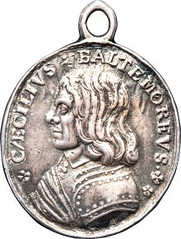
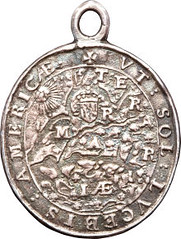
Betts-35. 1643-1644 Cecil Calvert Maryland Map Medal
The highlight is Betts-35, the circa 1643 Maryland Map Medal featuring Cecil Calvert, considered to be the first Indian Peace Medal awarded in the New World and the only peace medal ever awarded to the Susquehannock Indians.

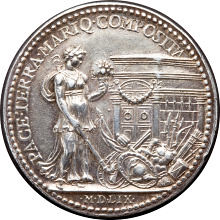 Betts-3. 1559 Peace of Cambrai
Betts-3. 1559 Peace of Cambrai
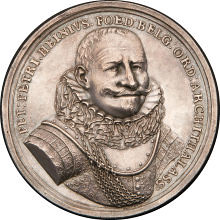
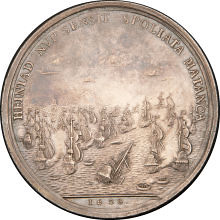 Betts-26. 1629 Heyn Victorious at Matanzas.
Betts-26. 1629 Heyn Victorious at Matanzas.
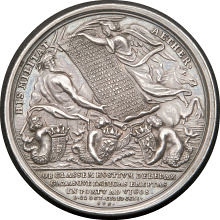
 Betts-94. 1702 Seizure of American Treasure at Vigo
Betts-94. 1702 Seizure of American Treasure at Vigo
To access the online catalog, see:
coins.ha.com/c/search.zx?saleNo=1181&collection=13&ctrack=596473&
type=rohan-adams-tem010313
THE BOOK BAZARRE
CORRECTION: STARR GILMORE BIBLIOGRAPHY
Last week I published an entry for author Starr Gilmore in Darryl Atchison's Canadian Numismatic Bibliography Darryl writes:
The text in the Gilmore entry did not include the correct bibliographical entries. Obviously, the text editor didn't like the <> marks in which each of the titles of the articles in question was contained.
Canadian dollars made at the Royal Canadian Mint since 1952. – Numismatic Scrapbook Magazine : Vol. 25, no. 2 (Feb. 1959). – p. 257 - 254. – very comprehensive review of the details concerning every issue including varieties and quantities allocated to various banks by type
Finale on Canadian dollars. – Numismatic Scrapbook Magazine : Vol. 25, no. 9 (Sep. 1959). – p. 2144 - 2153. – very detailed discussion of published errors concerning the designers and production of dollars and the identification of the principle collectors of Canadian dollars from around the world
Canadian dollars counterstamped “JOP”. – Numismatic Scrapbook Magazine : Vol. 26, no. 4 (April 1960). – p. 964 - 968. – an investigation into the appearance of dollars countermarked ‘J.O.P.’ which were first reported in the Winnipeg Tribune in 1947. Larry Gingras discovered that the issuer was Joseph Oliva Patenaude - a jeweller from Nelson, British Columbia. This article summarizes that story and greatly expands upon the existing body of knowledge about this subject
Canadian silver dollars : voyageurs and commemoratives. – H.C. Taylor; Somer James, Editors. – Winnipeg : Canadian Numismatic Publishing Institute, 1961. – 96 p., ill. – contains technical data and mintage figures for each silver dollar minted from 1911 - 1960
Parliamentary dollar background. – Numismatic Scrapbook Magazine : Vol. 28, no. 3 (March 1962). – p. 660 - 663. – detailed information about the background, production and distribution of the 1939 silver dollar commemorating the royal visit of King George VI and Queen Elizabeth
Double variant (two separate errors) Canadian dollar. – Numismatic Scrapbook Magazine : Vol. 30, no. 3 (March 1964). – p. 601 - 603. – the story of the discovery of a 1950 ‘Arnprior’ Voyageur dollar with both the variation in the normal three water lines at the bow of the canoe and the complete absence of the lower right group of Northern Lights. As of the date of publication, this was the only known example despite the knowledge that two different reverse dies were used for the 1950 production run. Logically many more examples should exist
Canadian dot coins. – Numismatic Scrapbook Magazine : Vol. 30, no. 6 (June 1964). – p. 1545 - 1549. – Elizabeth Wyn-Wood tells the story of why ‘dots’ were intentionally placed on the 1936 dies - including a description of how this was accomplished. She also states that “at least four dies of each denomination were so marked”. Curiously, the official Mint report fails to mention any ‘dot’ coins
Canadian dollar variants. – Numismatic Scrapbook Magazine : Vol. 30, no. 10 (Oct. 1964). – p. 2907 - 2909. – descriptions of silver dollar die varieties and feature errors
Canadian dollar history. – Numismatic Scrapbook Magazine : Vol. 30, no. 12 (Dec. 1964). – p. 3291 - 3293. – discussion of the emotions and economics contributing to a dramatic increase in the value of Canadian silver dollars
To read the earlier E-Sylum article, see: QUERY: INFORMATION ON AUTHOR STARR GILMORE SOUGHT (www.coinbooks.org/esylum_v16n01a22.html)
NOTES FROM E-SYLUM READERS: JANUARY 13, 2013
On Languages and Dialects
Ken Berger writes:
Bruce W. Smith refers to the Chinese dialects. I would argue that the word languages is a more acceptable term. Normally, dialects are intelligible to people who speak different ones (e.g. Australian English, British English, American English, etc.), whereas languages are not. In China, although the written form of a character is universal (of course, I am not considering traditional versus simplified forms of the characters), the pronunciation is completely different. Hence, although two individuals are able to read the written characters, they are unable to speak to each other. For example, it may be said that a person can read Chinese but you cannot say they speak Chinese. They speak, Mandarin, or Cantonese, or Taiwanese or whatever. So, I believe the term languages is more appropriate than the term dialects.
On a similar note, people quite often refer to the different Filipino dialects. Again, this is incorrect. Although the different languages in the Philippines often share the same grammatical construction, the words (spelling & pronunciation) is different. As such, they too are languages and not dialects.
To read the earlier E-Sylum article, see: NOTES FROM E-SYLUM READERS: JANUARY 6, 2013: More on Chinese Writing (www.coinbooks.org/esylum_v16n01a13.html)
Banks Had Taste
Dick Doty writes:
For what it's worth, the British Museum also has a 1796 quarter eagle, no stars, in proof, another donation from Miz Banks, around 1798. The woman had TASTE...
To read the earlier E-Sylum article, see: MORE U.S. COINS AT THE BRITISH MUSEUM (www.coinbooks.org/esylum_v16n01a11.html)
More on the Pour Buffle Medal
Serge Pelletier writes:
Leon Saryan wondered about the reason behind the award. Looking at the edge inscription “POUR BUFFLE” means either “FOR BUFFALO” or “FOR BUFFING WHEEL” in French.
To read the earlier E-Sylum article, see: QUERY: BOGHOS PASHA NUBAR MEDAL INFORMATION SOUGHT (www.coinbooks.org/esylum_v16n01a16.html)
On E-Sylumites
Regarding my use of the term " E-Sylumites", George Kolbe writes:
Let's hope they are not turned into pillars of salt…
To read the earlier E-Sylum article, see: BOOK REVIEW: THE 1815 HALF EAGLE (www.coinbooks.org/esylum_v16n01a09.html)
Prominent Numismatic Author Arrested For Counterfeiting!
Bill Rosenblum writes:
I found this interesting even before I read the name of one of the people arrested.
Four people — three men and a woman — have been arrested on suspicion of printing and passing counterfeit $20 bills in Teller County.
At about 10 a.m. Monday a suspect, identified as Monica Paradise, was taken into custody in Teller County and a search warrant was granted for a Woodland Park home, according to a Teller County Sheriff's Office media release.
The search warrant was executed by the sheriff's office, along with Woodland Park police and U.S. Secret Service agents, at about 5 p.m. Monday. Investigators seized counterfeit money and equipment used to produce the counterfeit bills, the sheriff's office said. Investigators interviewed two men at the home and they were arrested.
To read the complete article, see:
Four suspects in Teller County accused of counterfeiting $20 bills
(www.denverpost.com/breakingnews/ci_22333006/four-suspects-teller
-county-accused-counterfeiting-20-bills)
University of Colorado Offers Classical Greek Course Online
John Nebel writes:
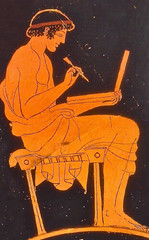 I've spent some time studying ancient Greek at Colorado University, and suggested that they do something similar online and the Classics department accepted a donation to get it off the ground. The online course is likely as intense as the on-campus ones, and highly recommended as the faculty are motivated, knowledgeable, and patient. One can't really do anything else for the duration of the course - commitment is required, but in the aftermath one will never again be intimidated by language.
I've spent some time studying ancient Greek at Colorado University, and suggested that they do something similar online and the Classics department accepted a donation to get it off the ground. The online course is likely as intense as the on-campus ones, and highly recommended as the faculty are motivated, knowledgeable, and patient. One can't really do anything else for the duration of the course - commitment is required, but in the aftermath one will never again be intimidated by language.
Correction: Email Address For Leon Saryan
Scott Barman pointed out a problem in last week's issue. Thanks. Turns out I missed a quote mark and that kept an email address from displaying properly. The correct address for Leon Saryan is:
Tramaked@aol.com
.
To read the earlier E-Sylum article, see: QUERY: BOGHOS PASHA NUBAR MEDAL INFORMATION SOUGHT (www.coinbooks.org/esylum_v16n01a16.html)
MORE ON JULES FONROBERT
I enjoyed the exchange about Jules Fonrobert in last week’s E-Sylum very much. I discussed this with Mark Borckardt and we think we can add a little to the discussion of how Fonrobert acquired his American coins.
Some time ago I purchased Harry Bass’s copy of the catalog of the Mendes I. Cohen Collection (Edward Cogan, 10/1875) which had been priced and named by William Poillon when he attended the sale. According to Poillon’s notes, a buyer named “Roberts” purchased 97 lots at the sale, including lot 379, a 1792 disme in silver, Judd-9, with the date effaced.
There are only three known specimens of this rare pattern in silver, and only one of them has the date effaced. Checking Die Jules Fonrobert’sche Sammlung ueberseeischer Munzen und Medaillen (Adolph Weyl, 12/1877), we found an example of the 1792 disme in silver in lot 366. The description includes the phrase “darunter 1792 fortgenommem” which means “underneath 1792 removed.”
It seems very unlikely that Fonrobert could have acquired this coin anywhere except the Cohen sale, so we concluded “Roberts” was an alias for Fonrobert. There are several other very rare coins that can be traced from the Cohen sale to the Fonrobert catalog. For instance, the 1794 half dime dies trial in copper in lot 380 of the Fonrobert catalog is specifically pedigreed by Weyl to lot 384 of the Cohen sale. According to Poillon, this lot was also purchased by “Roberts.”
It seems clear that Fonrobert must have participated in auctions in this country, using an alias or through an agent, while he was building his huge collection. Of course, he also purchased coins privately and bought entire collections outright, as Bob Leonard suggested in the E-Sylum post. The Adolph Weyl catalog of the North American portion of his collection includes more than 6,000 lots and this was not the biggest portion of his holdings. It is certainly remarkable how much he was able to accomplish in a relatively short time.
To read the earlier E-Sylum article, see: THE OBITUARY OF JULES FONROBERT (www.coinbooks.org/esylum_v16n01a19.html)
QUERY: WHAT IS THIS EBAY 'MINT DIE'?
Bruce W. Smith writes:
Check out this eBay lot. I'm not sure what it is, but I think E-Sylum readers would be interested. Can't imagine a brass die -- too soft. The round part looks to me like it is attached to the brass part. Round part also looks brand new and unused.

From the seller's listing:
This is quite the enigma I've come across. It's a brass token or coin die. I'm assuming a reverse die. It has the same eagle found on US gold coins from the 1800's and the word "Pheonix" on it. The image is backwards, so it comes out right when the coin is struck. The coin is 27mm, the same as a gold $10.00 eagle or a large cent/hard times token.
It was purchased at a flea market in Tennessee and was the only one the seller had. He purchased it from an estate with other numismatic items. In my research, I couldn't find any coins or tokens with this obverse. I have found other coin dies the same size with similar mounting holes. I was told from other dealers that it was most likely used or made for use with gold coins as gold is soft enough as to not damage the die with repeated use.
Several opinions seem to agree that it's from the 19th century, but I just can't find specifics as to its origin or use. It's professionally crafted and deserves to find its way into the hands of someone who can really appreciate the artistry or even use it. It would make a phenomenal die for striking bullion.
To read the eBay complete lot listing, see: 1800's Token or Coin Reverse Mint Die 27mm same as gold eagle or large cent (www.ebay.com/itm/181053923636)

2013 PRESIDENTIAL INAUGURAL MEDAL RELEASED
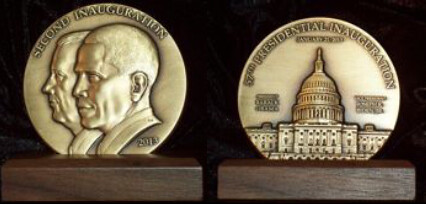
This handsome medal with the obverse executed by sculptor Peer Hansen will again be struck by the Medalcraft Mint, one of American's premier private mints.
The obverse bears Mr. Hansen's dual portraits of President Obama and Vice President Biden facing left. SECOND INAUGURATION is inscribed above and the date 2013 below. The reverse bears a detailed image of the U.S. Capitol with the legend above, 37th PRESIDENTIAL INAUGURATION. Inscribed to either side of the building is: PRESIDENT/ BARACK/ OBAMA at left, and VICE PRESIDENT JOSEPH R./ BIDEN, JR. to the right.
The medal program consists of the following:
2 3/4" BRONZE HIGH RELIEF ART MEDAL. (70mm). The most traditional medal of the inaugural series is this high relief bronze art medal. It comes will a solid walnut stand and is housed in a deluxe two-piece Kraft presentation box. RETAIL PRICE… $50.00
2 3/4” .999 SILVER HIGH RELIEF ART MEDAL (70mm) Design as above and also packaged in a Kraft presentation box RETAIL PRICE (and at this price - certain to be a low mintage rarity!) … $1,250.00
THREE PIECE MATCHED SERIAL NUMBERED SET. The set consists of the 2 _” bronze and silver medals and a 1 _” 1 oz. 14k gold medal housed in a custom wooden presentation case... $7,500.00
STICKER SHOCK? Trust me, you are not alone! Although the protests against the prices for the silver medal and the matched set have been vociferous, we do not anticipate the Inaugural Committee lowering the prices. Their response has been along the lines of saying that they feel that the quality of the medals warrants the price.
THE TED CRAIGE SALE, PART II
Harvey Stack writes:
We just issued a story about the forthcoming Ted Craige part 2 of his massive colonial collection to be sold as part of our AMERICANA SALE on January 24th in New York City, by STACKS BOWERS
The Ted Craige Collection has been off the market for some 40 years but has been legendary, as well as sought after by Colonial Collectors during the past four decades
There are numerous finest known examples, many great rarities and varieties and a full touch of what the collectors of yesteryear all sought to accomplish and acquire.
The series offered in the Craige Collection Part II are:
1. Silver coinage from the Massachusetts Bay Colony
2. Elephant Tokens
3. Pitt Tokens
4. Massachusetts Copper Coins
5. Connecticut Coppers
6. New Jersey Coppers
7. Washington Pieces
8. Fugio Coppers
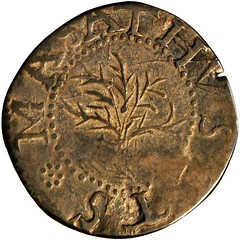 The session starts with the enigmatic Noe 2-B New England sixpence, one of just two known pieces in private hands, and continues with some very wholesome examples of the ever popular Oak and Pine Tree coins, including lot 11006, a lovely 1652 Oak Tree sixpence graded EF-45 by PCGS and among the finest known for the Noe-16 variety, and lot 11015, an unusually overweight Noe-10 Pine Tree shilling, weighing in at 76.38 grains and graded EF-45 by PCGS.
The session starts with the enigmatic Noe 2-B New England sixpence, one of just two known pieces in private hands, and continues with some very wholesome examples of the ever popular Oak and Pine Tree coins, including lot 11006, a lovely 1652 Oak Tree sixpence graded EF-45 by PCGS and among the finest known for the Noe-16 variety, and lot 11015, an unusually overweight Noe-10 Pine Tree shilling, weighing in at 76.38 grains and graded EF-45 by PCGS.
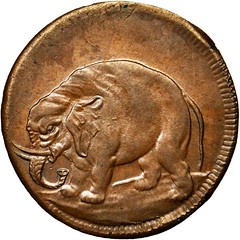 Craige’s Elephant tokens represent the finest offering since our (Stack’s) sale of the John J. Ford, Jr Collection, Part II. High grade and rare types and variants abound, including lot 11029, a rare God Preserve London struck over a CAROLVS A CAROLO halfpenny pattern. Graded MS-63 BN by PCGS, this is just one of four known example, tied with the 60th New Netherlands Sale piece for finest known. We are also offering two examples of the rare 1694 Carolina Proprietors O/E tokens.
Craige’s Elephant tokens represent the finest offering since our (Stack’s) sale of the John J. Ford, Jr Collection, Part II. High grade and rare types and variants abound, including lot 11029, a rare God Preserve London struck over a CAROLVS A CAROLO halfpenny pattern. Graded MS-63 BN by PCGS, this is just one of four known example, tied with the 60th New Netherlands Sale piece for finest known. We are also offering two examples of the rare 1694 Carolina Proprietors O/E tokens.
A small offering of Pitt tokens is highlighted by a rare brass farthing certified as having AU Details by PCGS, the firm noting Environmental Damage as the reason keeping the coin from a numerically graded encapsulation.
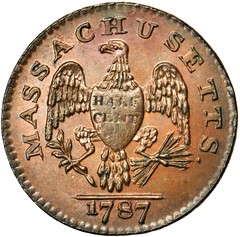 While the copper coins of New Jersey and Connecticut have large followings of specialists building collections of the various die marriages, the copper half cents and cents of Massachusetts are often overlooked by die variety collectors. Mr. Craige took “a workmanlike approach to filling in a set of…cents and half cents by Ryder number…” including several in the condition census. Lot 11042 features a 1787 half cent, Ryder 4-B that grades MS-63 BN -- a Rarity-5 coin that fits into the condition census and the ready equivalent of the Ford piece offered as lot 69 in our (Stack’s) sale of October 2004. The highlight of the set is the 1788 Ryder 13-I cent, graded as VF-20, cleaned; this Rarity-7 variety was missing from the Ford Collection, as well as many other extensive collections of colonial coins. In fact, Craige noted on his envelope “Unique. Unlisted, unpublished, and unknown combo.”
While the copper coins of New Jersey and Connecticut have large followings of specialists building collections of the various die marriages, the copper half cents and cents of Massachusetts are often overlooked by die variety collectors. Mr. Craige took “a workmanlike approach to filling in a set of…cents and half cents by Ryder number…” including several in the condition census. Lot 11042 features a 1787 half cent, Ryder 4-B that grades MS-63 BN -- a Rarity-5 coin that fits into the condition census and the ready equivalent of the Ford piece offered as lot 69 in our (Stack’s) sale of October 2004. The highlight of the set is the 1788 Ryder 13-I cent, graded as VF-20, cleaned; this Rarity-7 variety was missing from the Ford Collection, as well as many other extensive collections of colonial coins. In fact, Craige noted on his envelope “Unique. Unlisted, unpublished, and unknown combo.”
 The coins, tokens, medalets, and the like portraying various renditions of George Washington’s visage are numismatically referred to as “Washingtoniana.” Most collectors of colonial era issues are generally satisfied to own an example of each type. Die variety study and collecting of Washington pieces is not actively pursued by specialists. Ted Craige was well ahead of his time with his collection of Washington pieces, put away over 40 years ago. Our offering begins with the 1783 Washington Georgius Triumpho tokens, progressing to the 1783-dated Military and Draped Bust coppers, struck circa 1820. The number of die varieties offered is extensive, and is highlighted by the unique 1783 Draped Bust copper with the misspelled INDEPEDENCE in the legend. This is only the second time this coin has ever appeared at auction, first appearing in the New Netherlands’ sale of December 1968, lot 488, and is the plate coin in Breen (1988) and the 2nd edition of the Rulau/Fuld Washingtonia reference.
The coins, tokens, medalets, and the like portraying various renditions of George Washington’s visage are numismatically referred to as “Washingtoniana.” Most collectors of colonial era issues are generally satisfied to own an example of each type. Die variety study and collecting of Washington pieces is not actively pursued by specialists. Ted Craige was well ahead of his time with his collection of Washington pieces, put away over 40 years ago. Our offering begins with the 1783 Washington Georgius Triumpho tokens, progressing to the 1783-dated Military and Draped Bust coppers, struck circa 1820. The number of die varieties offered is extensive, and is highlighted by the unique 1783 Draped Bust copper with the misspelled INDEPEDENCE in the legend. This is only the second time this coin has ever appeared at auction, first appearing in the New Netherlands’ sale of December 1968, lot 488, and is the plate coin in Breen (1988) and the 2nd edition of the Rulau/Fuld Washingtonia reference.
Catalogs for this important collection are in the mail, and the listings are available on our website now at www.stacksbowers.com. This is just an overview of the 634 lots of coins in the legendary Ted L. Craige Collection, Part II. If colonial coins are of interest to you, there is definitely something in this offering for you, whether a seasoned specialist or a casual collector. As noted in our catalog of the Craige Collection, Part I (November 2012), this is a fresh a collection, which sat unmolested in a bank vault since the time of his untimely passing in 1971.
To read the complete article, see: Upcoming Events: The Legendary Ted L. Craige Collection, Part II (stacksbowers.com/Blogs/upcoming-events-legendary-ted-l-craige.html)
HARVEY STACK REMEMBERS HAROLD BAREFORD
 Harold S. Bareford was one of the great collectors of the mid 20th century. He was a constant visitor to the Stack’s offices or “club house” in the late 1940s, virtually up to the day he died.
Harold S. Bareford was one of the great collectors of the mid 20th century. He was a constant visitor to the Stack’s offices or “club house” in the late 1940s, virtually up to the day he died.
I met Harold in 1947 when he visited our shop at 12 West 46th Street. He often came by to see “what’s new.” He was a leader in collecting, proud of his collection, stubborn about quality, and always trying to acquire the best.
During the late 1940s and 1950s many of the collections formed in the earlier part of the 20th century were cataloged and put on the market. They offered a great source of specimens for Harold to consider.
I quote here from a biographical sketch, which appeared in Stack’s 1978 and 1981 catalogs:
“Harold Shaw Bareford was born April 21, 1894 in Millville, New Jersey, the youngest son of William Albert Bareford, master glass blower, and Mary Carey Shaw. Harold died suddenly at home on April 10, 1978, after spending a typically full day at his New York law office. He was a high school valedictorian in 1912 and graduated in 1916 from Cornell Law School with honors.
“He was commissioned in the field artillery at Plattsburgh in November of 1917 and served until December of 1918. He joined the law firm of Thomas & Friedman and soon became a full partner. In 1920 they joined the legal staff of their important client, Warner Bros. Pictures. In 1929 Bareford was made General Counsel, Assistant Secretary and Director of Warner’s. In 1943 he took a leave of absence to go on active duty as a Captain in the Coast Artillery. Discharged as a Major 1945, he returned to Warner’s and on his retirement in 1959 he resumed full time private practice.
“Harold Bareford became a serious numismatist after the Second World War and was a member of the ANA and the BSN, a fellow of the ANS and the RNS, and a member of the 1969 Federal Assay Commission. He was an officer from its inception of the Metropolitan New York Numismatic Convention, serving with such numismatists as Raymond Gallo, Vernon Brown, Martin Kortjohn and Edward Hessberg. He was also president of the New York Numismatic Club from 1959 through 1961.”
Stack’s was privileged to sell Harold’s collection of United States gold coins at public auction on December 1, 1978. Collectors and numismatic writers throughout the country acclaimed the quality and importance of that collection. The United States silver coins were of comparable quality and importance and received the same accolades as the gold collection.
Because of Harold’s exacting standards, he bought very few of the larger gold coins as they were rarely to be found in the condition he desired. He concentrated on half eagles and smaller denominations. For example, he was able to assemble a remarkable and nearly complete collection of gold dollars. There were a few missing because he never was able to find suitable specimens and would not buy inferior ones. His collection also contained a nearly complete set of Charlotte and Dahlonega quarter eagles and half eagles in Gem condition, a spectacular run of $3 coins, and many exquisite Proofs in all denominations. The collection included such classic rarities as the 1795 half eagle with Large Eagle reverse, the 1848 CAL. quarter eagle, the 1875 dollar, quarter eagle and half eagle, and the 1933 eagle.
To read the complete article, see: Remember When: Harold Shaw Bareford, A Legendary Collector (stacksbowers.com/Blogs/remember-when-harold-shaw-bareford.html)
ARTICLE PROFILES NUMISMATIST EDWARD T. NEWELL
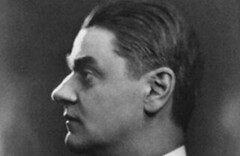 Last week's question: What native Kenoshan was considered the greatest coin collector of his generation by the American Numismatic Society?
Last week's question: What native Kenoshan was considered the greatest coin collector of his generation by the American Numismatic Society?
Answer: Edward T. Newell wasn't a name I was familiar with, but then again, I'm not into coin collecting.
Newell certainly was. Coins were his passion.
Newell was the world’s leading expert on the coins of Alexander the Great.
His collection of more than 87,000 coins was considered the largest private collection of Greek coins in the world at the time of his death in 1941.
In his will, he bequeathed this mammoth collection to the American Numismatic Society, the largest single donation ever given to the society.
Bain Wagons source of wealth
Newell was born in the high society of Kenosha in 1886, the second child of Frederick and Frances Newell. Frances was the daughter of Edward Bain, founder of the Bain Wagon Co.
The family drew its wealth from the Bain company, which at the turn of the century was the world's largest manufacturer of wagons.
By the 1890s, Edward and his sister Moyca had traveled with his parents eight times to Europe, and they also visit Egypt. Edward was a quirky kid, even for rich kid standards of the day. By the time he was 10 years old, he knew most of the battlefields of Europe and the battles that were fought on each one. Family memorabilia points to young Edward starting his coin collecting during this time.
Sadly, neither parent lived to see their son's success. Frederick died in 1902, when Edward was 16, and Frances died five years later.
When Frances took the mantle of widowhood, she became one of Wisconsin's wealthiest women. Conservative estimates placed her private fortune at several million dollars.
It was Edward's share of this family fortune that financed his amassing thousands of coins.
Leads the American Numismatic Society
He excelled at his classes at Yale University, and by his sophomore year he had been accepted as a member of the American Numismatic Society. The following year he was named a fellow of the Royal Numismatic Society.
After his ANS membership was confirmed, he visited the society almost weekly for five months and soon published his first numismatic article, "A Survey of the Coinage of Alexander's Successors.” He went on to write many more unpublished manuscripts.
While his fellow students at Yale had their senior portraits taken head-on, Newell had his portrait taken in profile, just like all the great coin images in world history. He continued to have his portrait taken in this manner for the remainder of his life.
To read the complete article, see:
Kenosha man amassed largest private collection of Greek coins
(www.kenoshanews.com/news/kenosha_man_amassed_largest_private
_collection_of_greek_coins_469495575.html)
NUMISMATIC VOCABULARY WORDS: PINSCRATCH AND FACEPLATES
Heritage Auctions Chief Cataloger Mark Van Winkle was kind enough to send me the auction house's Style Sheet (of 35 pages) after its mention on The E-Sylum a few weeks back. I'm a style rules junkie in the numismatic field (should "mint mark" be spelled one word or two? -- most everybody prefers one!).
But I learned a new word or two among those hundreds of recommendations. One word was "pinscratch." I don't remember ever having encountered it before. Heritage recommends it as one word. I like that. It is an excelled term for obviously the lightest scratches on a numismatic item.. A reader does not need a college degree to understand exactly what it means.
My first thought was "how does it differ from hairline"? Then it dawned on me. Hairline is a thin raised line from a crack in the die. Pinscratch is a tiny trench in the surface of a numismatic item. A complete opposite. No relation at all, other than their wispy nature.
Another term new to me was "faceplates" when describing Kellogg and Humbert gold pieces (page 22). I can guess what it means. I prefer a more precise definition from one of our more knowledgeable readers. What's a faceplate on a gold piece?
I have style sheets from the American Numismatic Society, Coin World, and now Heritage. If your organization has such a document, would you mind sharing it with me? I get my jollies from reading such numismatic esoterica. dick.johnson@snet.net
FORMER U.S. MINT DIRECTOR MOY ON THE TRILLION DOLLAR COIN
The $1 trillion platinum coin is a desperate gimmick of questionable legality and doesn't even come close to solving our fiscal problems.
First, it may be legal to mint a platinum bullion coin with a $1 trillion face value, but it's not legal to pass it off as actually worth $1 trillion if there isn't $1 trillion of platinum in it. That's because it's a bullion coin and not a legal circulating coin. The face value of a bullion coin has no relationship with the metal content because the value is in the metal, whose price fluctuates daily.
Second, for a coin to be worth its face value, it has to be made as a circulating coin.
Here's how a circulating coin is made. Congress needs agree on the metal content, dimensions, the designs on the heads and tails sides, weight, and other details. Then they have to pass legislation to create a $1 trillion circulating coin. The President needs to sign it. Then the Mint would have to design it get the design approved, procure whatever new materials they need, make the dies, test production, and then make one. Then a bank would have to order one because a business customer needed it to make change. The Fed would pay the Mint face value for the coin. After deducting the cost of the coin, the Mint would return the balance to the Treasury. All this needs to be done before we run out of money. Good luck with that.
Third, the current law does allow the Mint to make a platinum proof coin and does not specify whether this applies to a bullion coin or a circulating coin. A proof coin refers to a mirror-like finish and is made for coin collectors. However, a proof coin must be accepted at face value. Some have argued that the law can be stretched to allow for a platinum circulating coin, but this would not be consistent with the intent of the original legislation.
Recently, I made a quarter "disappear" for my young daughters by using misdirection to make that sleight of hand magic trick work. Like misdirection, the notion of a $1 trillion coin directs attention away from real solutions. And it gives a false hope to those fantasizing for a painless, simple, and quick solution.
The only solutions left are the hard ones. We can raise revenue, cut spending, or do some combination of the two. Regardless, it has to be big and deep enough to matter.
To read the complete article, see: Former U.S. Mint Director: The $1 Trillion Platinum Coin Ain't Worth a Plugged Nicke (www.cnbc.com/id/100364183)
Minting such high-value coins to pay the government's bills would allow President Obama to sidestep a showdown with Republicans over the federal debt ceiling.
The proposal would involve the Treasury minting the coin and depositing it into its own account at the Federal Reserve, allowing the government to write down or cancel $1 trillion of its $16.4 trillion debt.
Economist and Nobel prizewinner Paul Krugman, one of those backing the idea, said the time had come to use any economic tools available to the Government.
Writing in his blog on the New York Times website, Mr Krugman said: ‘This is all a gimmick – but since the debt ceiling itself is crazy, allowing Congress to tell the President to spend money then tell him that he can’t raise the money he’s supposed to spend, there’s a pretty good case for using whatever gimmicks come to hand.’
Will a $1 trillion coin solve the debt crisis? Plan to mint platinum currency that Treasury will pay itself
(www.dailymail.co.uk/news/article-2258748/Republicans-seek
-block-Obama-administration-trying-mint-1-trillion-coin.html)
From Alan Luedeking: Who, What, Why: Could the US get a $1tn platinum coin (www.bbc.co.uk/news/magazine-20951417)
Platinomics: The economics of the platinum coin option (www.economist.com/blogs/freeexchange/2013/01/economics-platinum-coin-option)
Alan adds:
I hope I can order one from the mint! Perhaps I can pay for it with Zimbabwean dollars!
From Kavan Ratntunga White House: $1 trillion coin off table (http://www.salon.com/2013/01/12/white_house_1_trillion_coin_off_table/singleton/)
INFLATION MONEY AND PROPOSED PLATINUM COIN DESIGNS
I'm sure that by now, most E-Sylum readers have heard about the Trillion-Dollar coin. I first heard of the idea in 2011.
The theory goes that while there are laws in place to regulate how much paper, gold, silver or copper currency can be circulated by the government, there is nothing so clearly stated when it comes to platinum coins. That door open, the Treasury could have the U.S. Mint produce a Trillion-Dollar platinum coin (or more than one), then ship the goods over to the Federal Reserve who could use them to service the US Debt. As absurd as it sounds, many believe it is technically possible within current laws. One member of Congress has already proposed a law to stop such a coin from being minted!
Although I don't think it will happen, I like the prospect. I have long collected high denomination coins and paper money. Remember the German Notgelt from the early 1920s? I have a nice collection of those collected when I was stationed in Stuttgart, Germany in the early 1970s.
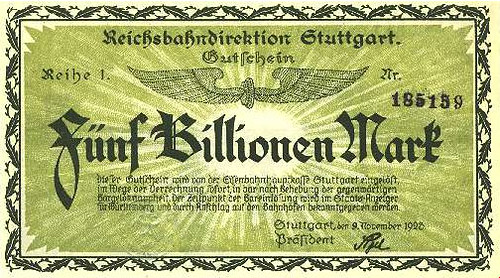
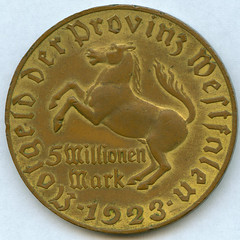 And I have, in my collection, many of the German coins of the same era, from 10 Marks to 50 million Marks, all of the same design.
And I have, in my collection, many of the German coins of the same era, from 10 Marks to 50 million Marks, all of the same design.
And, you probably remember the recent hyper-inflation in Zimbabwe when they issued a legal tender 100 Trillion Dollar note:
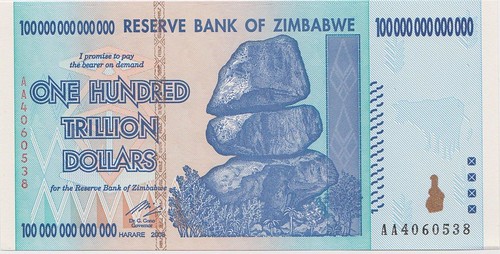
I guess that now they only have to agree to a design for the new coin. Here are three recommended designs I found. Others recommend a Reagan design.
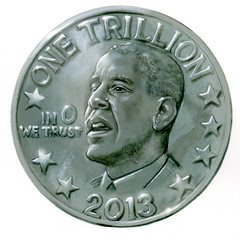
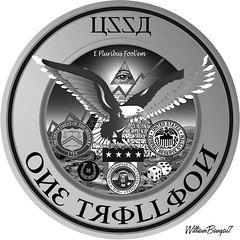
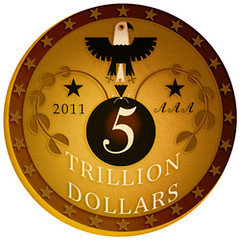
J.P. MORGAN'S 1895 COIN LOOPHOLE GAMBIT
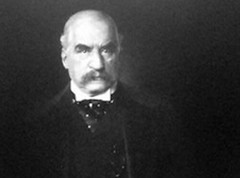 By now you've probably heard the Treasury say they will not be minting a $1 trillion coin to help the U.S. avoid the debt ceiling.
By now you've probably heard the Treasury say they will not be minting a $1 trillion coin to help the U.S. avoid the debt ceiling.
But the federal government exploiting obscure loopholes under moments of extreme duress is not without precedent.
At the beginning of 1895, the country was facing default after its gold reserves evaporated. But through some legal archaeology JP Morgan located an obscure, Civil War-era statute that would allow he and some fellow international financiers to replenish the Treasury's gold stocks. The country was saved.
With the help of Bancroft Prize-winner Jean Strouse's biography "Morgan," we retell the story.
Fearing rising U.S. demand for cheap money, foreign investors continue to sell American securities and take the proceeds home. Between 1890 and 1894 anxious creditors unload $300 million worth of American securities and transferred gold abroad.
"Since there was no income tax and the government had no power to issue money, the Treasury had to buy or borrow gold in order to maintain its reserve.
By February 1894, Treasury was losing over $2 million a day. The government would default in three weeks' time.
Morgan's been mulling the problem. He reasons that he could probably corral a group of international bankers to buy out a new bond issue, but the government would have to back it in gold or sterling. But the problem again: Congress must authorize all gold bond issues.
Thirty-three years [before], in the throes of the Civil War, Congress had authorized Treasury Secretary Salmon P. Chase to issue bonds that could be offered for coin. If the gold bailout Morgan was proposing could be considered a bailout in coin, it would not require Congressional approval.
The final terms are struck, with the government agreeing to get slightly hosed.
The government will buy 3.5 million ounces of gold coin from the bailout team at $17.80 per ounce, in exchange for $62.3 million worth of 30 year bonds paying 4%. The price of gold is actually $18.60, so the government ends up paying for $65.1 million in gold in exchange for $62.3 million in bonds — paying a $3 million premium. The syndicate would have six months to complete the contact, and would procure half the new gold abroad at a rate not exceeding 300,000 ounces a month.
Twelve days later, the bond issue was offered and sold out in 20 minutes.
To read the complete article, see: The True Story Of The Time JP Morgan Saved America From Default By Using An Obscure Coin Loophole (www.businessinsider.com/morgan-1895-crisis-and-1862-gold-loophole-2013-1)
COULD THE U.S. GOVERNMENT ISSUE WARRANTS?
We’ve heard all this talk about the trillion dollar coin to solve the debt ceiling problem. But what USC professor Edward Kleinbard proposes something a little different in his op-ed for the New York Times:
“However, there is a plausible course of action, one that the president should publicly adopt in the coming weeks as his contingency plan should debt-ceiling negotiations falter. He should threaten to issue scrip — “registered warrants” — to existing claims holders (other than those who own actual government debt) in lieu of money. Recipients of these I.O.U.’s could include federal employees, defense contractors, Medicare service providers, Social Security recipients and others.”
Kelinbard said the idea of IOUs is just less risky than the trillion dollar coin. He said it “stands on much firmer constitutional ground” and exposes the president to a lesser risk of impeachment.
Kleinbard argues that the IOU doesn’t promise to pay you any money at any particular time. The IOU would basically say “we’ll pay you money but we just can’t do it right now."That doesn't seem great for a 68-year-old on Social Security on the face of it -- but Kleinbard argues that government IOUs could be good for both banks and ordinary people.
“You turn around and sell it for a small discount, and the banks will say ‘we’ll buy it at a small discount’. Think what U.S. Treasury bills yield right now. If you bought this paper at a 1 percent discount and the issue was resolved in a month. You would be getting a return of 1 percent a month instead of 1 percent a year. The financial institutions would find this attractive,” said Kleinbard.
Kleinbard said neither an IOU program nor the trillion coin are good ideas, but it’s all about which plan is best to “defang an artificial crisis and enable us to have the debate we need to have about long term spending in regular order.”
To read the complete article, see:
Forget the trillion dollar coin: Try the IOU
(www.marketplace.org/topics/economy/raising-debt-ceiling/
forget-trillion-dollar-coin-try-iou)
To read the earlier E-Sylum article, see: BANKRUPT CALIFORNIA ISSUES PAYMENT WARRANTS (/www.coinbooks.org/esylum_v12n28a17.html)
THE BOOK BAZARRE
NISEI CONGRESSIONAL GOLD MEDAL GOES ON NATIONAL TOUR
 Herbert Yanamura is an American, born and raised among the coffee farms of Hawaii's Kona district. Yet the U.S. government branded him an "enemy alien" after the 1941 bombing of Pearl Harbor because he looked like the invaders.
Herbert Yanamura is an American, born and raised among the coffee farms of Hawaii's Kona district. Yet the U.S. government branded him an "enemy alien" after the 1941 bombing of Pearl Harbor because he looked like the invaders.
So Yanamura volunteered to join the Army to prove his loyalty.
Nearly 70 years later, that same government honored him and the thousands of other Japanese-Americans who served in World War II with one of its most elite rewards: the Congressional Gold Medal.
Starting this weekend in New Orleans, the medal is going on a yearlong national tour that will spread the stories of the veterans, their sacrifices and their triumphs. The tour is organized by the Smithsonian in partnership with the National Veterans Network, a coalition of Japanese-American veteran and civic organizations.
"For a lot of younger people, World War II is like ancient times," Inouye said in a telephone interview. "We have to remember that there are a lot of younger people who just have not been exposed to the story."
Congress last year awarded the medal collectively to men who served in three segregated units of mostly Japanese-Americans: the 100th Infantry Battalion — nicknamed the Purple Heart Battalion because of the casualties it endured— the 442nd Regimental Combat Team and the Military Intelligence Service. Besides these units, it was rare for Japanese-Americans to serve in other parts of the U.S. military.
Japanese-Americans were at first not allowed to serve, rendered ineligible for the draft because of their "enemy" status.
But in 1943, the government decided to allow some to volunteer.
The Army put out a call for 1,500 to come forward; more than 10,000 raised their hands.
Yanamura's homeroom teacher (also Japanese-American) told his class all 18-year-olds should volunteer to prove their loyalty.
"I went home from school and talked to my father. He said, without any hesitation, 'You must volunteer. You got to show your loyalty,'" Yanamura said.
He first joined the 442nd but switched to the MIS after realizing he would be more useful as a linguist than as an infantryman.
He was awarded the Bronze Star for using a loudspeaker to successfully coax 1,500 civilians and 150 soldiers in the village of Maehira to surrender during the Battle of Okinawa.
He never spoke much of his actions until recently, modestly saying "we really didn't do much." And he at first doubted whether he should be honored by the same award given to George Washington and other American heroes.
But he's come to accept the medal as an apology to men who risked their lives even though their country treated them as enemies and imprisoned their families in concentration camps.
"Despite all that, we still went ahead and performed outstandingly," he said. "From that standpoint, I guess, we should be thankful that the recognition has been made, though a long time later."
Yanamura, now 88, and Inouye will attend a ceremony opening the exhibition on Saturday at the National World War II Museum in New Orleans. The medal will travel to museums in Honolulu, Los Angeles, San Francisco, Portland, Ore., Chicago and Houston over the next year.
To read the complete article, see: CONGRESSIONAL GOLD MEDAL GOES ON NATIONAL TOUR (bigstory.ap.org/article/congressional-gold-medal-goes-national-tour)
At the conclusion of the tour, the Congressional Gold Medal will be on permanent display in “The Price of Freedom” exhibition at the National Museum of American History in Washington, D.C.
The medal will be accompanied by an educational package with an iPad application, social-learning website and curriculum developed by the National Veterans Network in partnership with the Smithsonian Asian Pacific American Program. Centered on the character values associated with Japanese American veterans—courage, respect, humility, perseverance, compassion and citizenship—these materials will provide users with a constantly growing, social-learning community.
The Congressional Gold Medal was awarded to the 100th Infantry Battalion, the 442nd Regimental Combat Team and the Military Intelligence Service veterans by the U.S. Congress Nov. 2, 2011, in recognition of their exceptional service, sacrifice and loyalty to America. The Gold Medal represents Congress’s highest expression of national appreciation for distinguished achievements and contributions.
Commonly known as the “Go for Broke” regiments, the 100th/442nd is one of the most highly decorated units in U.S. military history, having earned more than 4,000 Purple Hearts, 560 Silver Stars, seven Presidential Unit Citations and 21 Medals of Honor. The MIS, whose highly specialized contributions helped hasten the end of the war, was honored with a Presidential Unit Citation in 2000. More than 19,000 Japanese American soldiers served in these units during World War II.
The national tour of the Nisei Congressional Gold Medal is made possible by the support of AARP, Comcast/NBC Universal, Cole Chemical, Southwest Airlines and Pritzker Military Library.

The medal's obverse (heads side) design features Nisei (second-generation Americans of Japanese ancestry) Soldiers from both the European and Pacific theaters. The 442nd RCT color guard is depicted in the lower field of the medal. The inscription “Go For Broke” is the motto of the 442nd RCT, and was eventually used to describe the work of all three units.
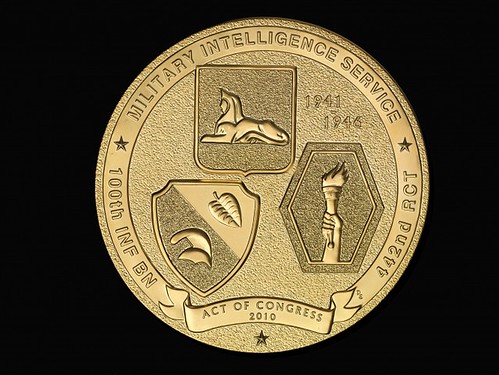
The medal's reverse (tails side) depicts the insignias of the 100th INF BN, 442nd RCT, and MIS. The 100th INF BN insignia features a taro leaf and a traditional Hawaiian helmet, both of which are emblematic of the unit's Hawaiian roots. The "Go for Broke" Torch of Liberty shoulder patch represents the 442nd RCT. The sphinx, a traditional symbol of secrecy, represents the MIS insignia
To read the complete Smithsonian press release, see:
Smithsonian Announces Seven-City Tour of Congressional Gold Medal Awarded to Japanese American World War II Veterans
(newsdesk.si.edu/releases/smithsonian-announces-seven-city-tour-
congressional-gold-medal-awarded-japanese-american-wo)
NUMISMATICS IN THE PRINCIPALITY OF MONACO
Yachts, luxuries, gambling casino – an ambience barely suited for a down-to-earth coin collector? On the contrary, when coming in the off season the Principality of Monaco has much to offer in regard to numismatics, like an attractive coin fair. How I got to know that? Well, I took the recent Monégasque coin fair on December 2, 2012, as an opportunity to reconsider all my prejudice and travelled to Monaco myself.
First of all, the rumor that in Monte Carlo only the super rich can buy anything and everything is not true – at least not in December. On the occasion of the coin show, exhibitors and guests of the Monaco International Coin Fair can enjoy a very reasonably priced rate which charges a price for a room in a five star hotel you would expect in a four star hotel in the major cities. When strolling through the town you will find – as in any other place in the world – expensive tourist traps as well as good restaurant with decent prices.
So much for local color, let us turn to numismatics now. Once every year, Editions Victor Gadoury organizes an international coin show that takes place high above the glamorous marina next to the famous Musée des Timbres et de Monnaies. Usually, though, not that many people queue up to visit the museum.
But, on the occasion of the coin fair, the latest special coin can be purchased at the ticket office of the Musée des Timbres et de Monnaies at issue price. It is the 2 euro commemorative coin on 500th anniversary of foundation of Monaco’s sovereignty and the 10 euro coin with the image of Honoré II. They were sold out already before noon. That made it easier to get access to the exhibition rooms which are quite worth visiting!
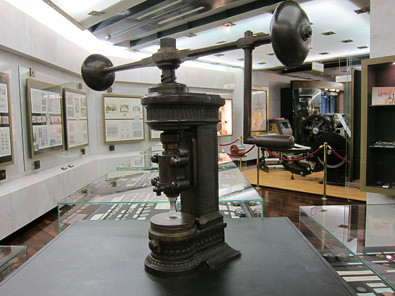
A balancier, not for minting but for punching out the planchet
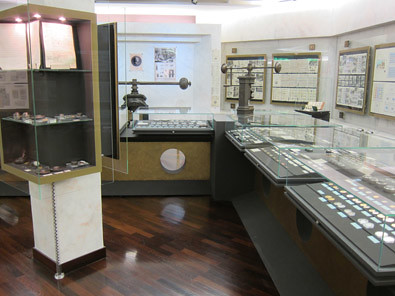
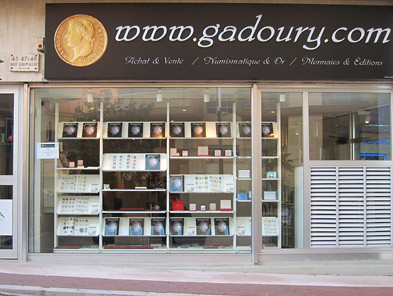
auction house Editions V. Gadoury
To read the complete article, see: Numismatics in the Principality of Monaco (www.coinsweekly.com/en/News/4?&id=1716)
QUERY: W.W.C. WILSON COMMERCIAL TERCENTENARY MEDAL INFO SOUGHT
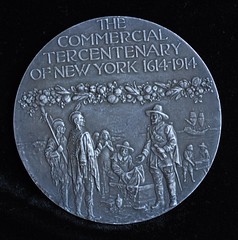
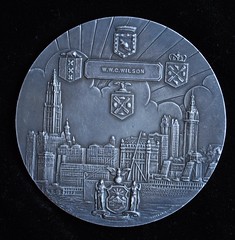
Geoffrey Bell writes:
I have a Tiffany silver medal of the Commercial Tercentenary of New York 1614 - 1914. It has a struck plate naming W.W.C. Wilson. Of course, he is a famous early Canadian numismatist. Would he have purchased the medal (as I think that was possible), or would some person on the committee have seen that he was awarded the medal? If any of our readers might be able to answer I would be most appreciative.
THE BOOK BAZARRE
TREASURY SECRETARY NOMINEE JACK LEW'S LOOPY SIGNATURE
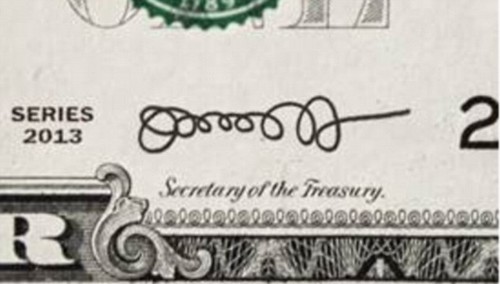
Lew, who would replace outgoing secretary Timothy Geithner if he is confirmed into the role, has an almost comedic signature which resembles a spring, an extended slinky or a curly French fry.
If Lew does become Secretary of the Treasury, it will appear on dollar bills and he may well have to take a few tips, as Geithner did, to improve the legibility of his signature
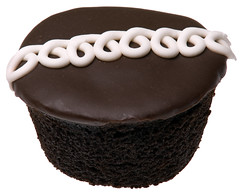 President Obama made fun of Lew's signature when he announced the appointment, saying he made lew promise to make "at least one letter" legible. With Lew they may want to call in a Catholic grade school nun with a well-used ruler.
President Obama made fun of Lew's signature when he announced the appointment, saying he made lew promise to make "at least one letter" legible. With Lew they may want to call in a Catholic grade school nun with a well-used ruler.
Be sure to read the full article - they have a great quiz to see who can recognize the signatures of several famous people and great historical figures. -Editor
To read the complete article, see:
Will this be the worst signature EVER to grace a dollar bill? Revealed, the new Treasury Secretary's childish squiggle
(www.dailymail.co.uk/news/article-2259838/Jack-Lew-Will
-new-Treasury-Secretarys-worst-signature-EVER-grace-dollar-bill.html)
QUERY: INFORMATION ON DENNIS W. SIBERT SOUGHT
I have a question for E-Sylum readers. Does anyone know anything about Dennis W. Sibert? In 1946 he twice ran a full page ad in The Numismatist announcing a new book on the silver dollars of China, to be co-authored by himself and H. Chang, a coin dealer in Shanghai. Another ad in Numismatist in 1948, placed by his wife, said that due to Sibert's ill health, the book plan had been cancelled and advance payments had been refunded.
I came across these advertisements some time ago, and put a card in my bibliography in case any other information turned up. Last night I discovered that I have the manuscript and many of the photos for that book. It came from the Howard F. Bowker library in the form of a binder, but with no title page or author shown. Stuck in the manuscript is the top half of a letter addressed to "Mr. Sibert". The name rang a bell and led me to my card file.
A Google search provided the following information: Dennis Willie Sibert (1912-1991) was born and died in Alabama. He enlisted in the U.S. Army 9 September 1942 and was a captain and later a major. At the time of his death (21 February 1991) he lived in Mentone, AL, which was also where he lived in 1946. He received his social security number in New York, so he must have lived there at one time. In 1955 he and his wife, Helen, flew into New York from Frankfurt (Germany?). In the Bowker-Coole correspondence, Bowker mentions that Sibert was working on a book on Chinese silver dollars and had obtained photos of Eduard Kann's coins.
Beyond that, I know nothing about Sibert. What happened to him after 1948? I suspect he was an ANA member, but I didn't find anything about him in the indexes to The Numismatist (though the last one was published in the 1980's -- before Sibert died). He must have recovered from his 1948 illness, since he was able to travel in 1955 and lived until 1991. I found a photo of him, in WWII uniform, online and have attached it.
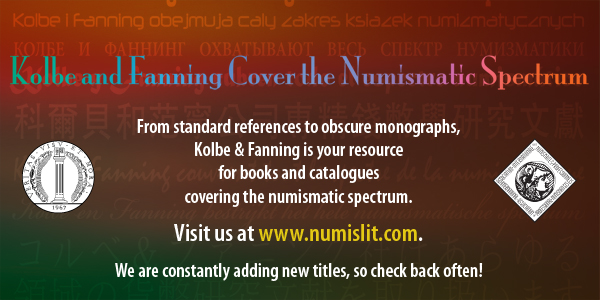
ANCIENT GOLD COIN HOARD DISCOVERED IN IRAQ
 Iraqi archaeologists have found 66 gold coins that are at least 1,400 years old, officials said on Monday, adding that they hope to put them on display in Baghdad's National Museum. The artefacts, which date back to the Sassanid era that extended from 225 BC to 640 AD, will be sent for laboratory tests in order to confirm their authenticity. They were discovered in the town of Aziziyah, which lies 70 kilometres (40 miles) southeast of Baghdad in Wasit province, according to Hassanain Mohammed Ali, director of the provincial antiquities department. The coins bore drawings of a king or god and depicted flames, he said.
Iraqi archaeologists have found 66 gold coins that are at least 1,400 years old, officials said on Monday, adding that they hope to put them on display in Baghdad's National Museum. The artefacts, which date back to the Sassanid era that extended from 225 BC to 640 AD, will be sent for laboratory tests in order to confirm their authenticity. They were discovered in the town of Aziziyah, which lies 70 kilometres (40 miles) southeast of Baghdad in Wasit province, according to Hassanain Mohammed Ali, director of the provincial antiquities department. The coins bore drawings of a king or god and depicted flames, he said.

To read the complete article, see: Iraqi archaeologists unearth sixty-six gold coins that are at least 1,400 years old (artdaily.com/index.asp?int_sec=2&int_new=59994#.UOzG0m9lEfM)
ALAN V. WEINBERG'S REPORT ON THE 2013 F.U.N. SHOW
I'm back having attended from opening setup day thru Saturday. As I've long thought, this January Florida United Numismatists show is actually superior in all aspects to the summer ANA, which is at least twice as expensive to attend (bourse, hotel rooms, restaurants, etc). Not to speak of the FUN's setup day free sandwich buffet for dealers who've not eaten since breakfast and the daily coffee and fresh fruit / bagels & danish free buffet for dealers arriving at 8:30 AM.
I went home with some prized acquisitions for my collection, most notably a high grade gold brooch cameo of John Quincy Adams - who was initially President and son of 2nd President John Adams and later distinguished himself as the defense in the infamous Amistad slave smuggling trial - from dealer/collector
Rex Stark who acquired it in November from Skinner's auction of the JQA family descendants' possessions, the same auction containing JQA's gold Erie Canal medal. And a completely hand-engraved portrait shooting award silver medal from 1847 depicting Gen'l JS Taylor's full face image from Harv Gamer and a cased silver rare 1898 Agricultural award medal , which I've never seen before, from dealer/collector John Kraljevich. I've long believed the best dealers are collectors themselves.
The show was sold out with over 600 bourse tables. Literally mobs of people were there and they were spending.
The much anticipated StacksBowers Americana catalogue was not available at the show but soon as I got home late Saturday night, a splendid copy was waiting for me in the mail. Couple of days of good reading and careful selection coming.
I learned master numismatic photographer Tom Mulvaney is running for the ANA Board of Governors and I happily signed his election petition. He will be a breath of fresh air in the organization and has historically worked closely with one of the finest professional numismatists Jeff Garrett running for, I believe, the ANA Vice Presidency.
While acquiring the aforementioned rarities was very fulfilling, I must say the high point of my Orlando attendance was the opportunity to preview at Fred Holabird's bourse table a set-up copy of Karl Moulton's long-anticipated 900+ page Paul Franklin./John J. Ford, Jr. book. I wasn't about to lay out $250 pre-publication price before seeing the book. I'm as careful with the dollar as anyone in desiring real value for my $1.
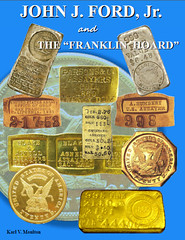 I was mesmerized by the quality content of the 900+ pages. Not technical at all, not dwelling exclusively on the fake pioneer ingots, it is a study into the soul of probably the most fascinating and controversial 20th century numismatist and his business dealings with Norweb, the Stacks, Kosoff, etc. replete with numerous plates of his correspondence, both sent and rec'd. It is not at all stuffy or technical, more like a fly on the wall's view of prominent numismatists in the 1940-80's. Projected release in March, afterwards $295, I've just mailed my $250 check- money very well spent. Probably the most fascinating numismatic book I'll ever read.
I was mesmerized by the quality content of the 900+ pages. Not technical at all, not dwelling exclusively on the fake pioneer ingots, it is a study into the soul of probably the most fascinating and controversial 20th century numismatist and his business dealings with Norweb, the Stacks, Kosoff, etc. replete with numerous plates of his correspondence, both sent and rec'd. It is not at all stuffy or technical, more like a fly on the wall's view of prominent numismatists in the 1940-80's. Projected release in March, afterwards $295, I've just mailed my $250 check- money very well spent. Probably the most fascinating numismatic book I'll ever read.
As I have for over a decade now, I exhibited non-competitively at the FUN show- this time my five high quality 1793 Chain cents. Exhibiting gives me a lot of satisfaction, rather than have my treasures locked up in a dark bank vault. There are no headaches like having to abide by strict exhibition rules on labeling, etc. or having to remain at the show until the final hours on Sunday. Not if you exhibit non-competitively- you make your own rules and can arrange to disassemble the exhibit Sat afternoon. Fran Lockwood, FUN's longtime exhibit chairman, is very easy to work with if your exhibit is worthwhile. Heck ,it can even be one single case as mine was.
FUN was a happy and rewarding experience, once again.
SUSPECT TRIES TO EAT COUNTERFEIT MONEY
A North Carolina man who reportedly tried to eat fake bills stored in his shoe after being confronted by police faces numerous counterfeit charges, along with another man and a minor who were with him.
Johnson City police received a call from IHOP, 3214 Peoples St., early Wednesday claiming some customers tried to pass a counterfeit bill but fled after employees became suspicious, according to a news release.
A court document indicated one of the men ordered pancakes to go and tried to pay with a $50 bill the cashier thought looked fake.
Police said in the release these two men and the juvenile male then went to McDonald’s, 2101 North Roan St., and bought food with fake money.
Court documents allege the three pulled through the restaurant’s drive-thru and gave the cashier a fake $50 bill to pay for their order.
The employee told the driver to pull around so change could be made for the $50.
McDonald’s employees called police, who confronted the men.
To read the complete article, see: Police say N.C. man tried to eat fake money; three face counterfeit charges (www.johnsoncitypress.com/News/article.php?id=104114)

